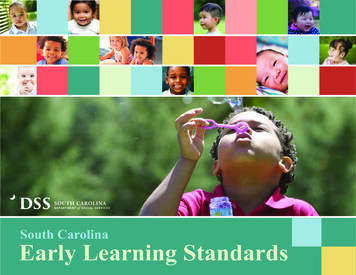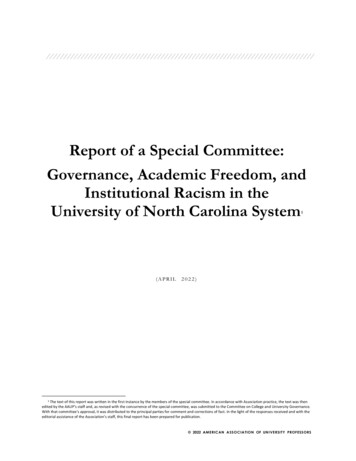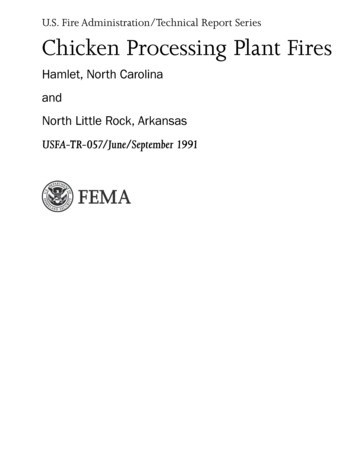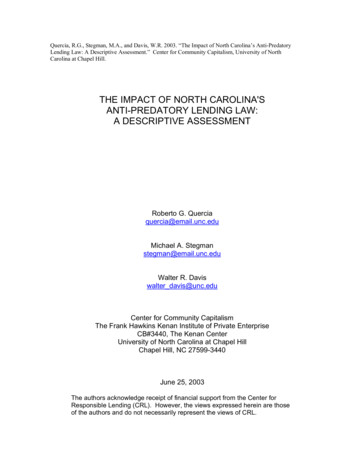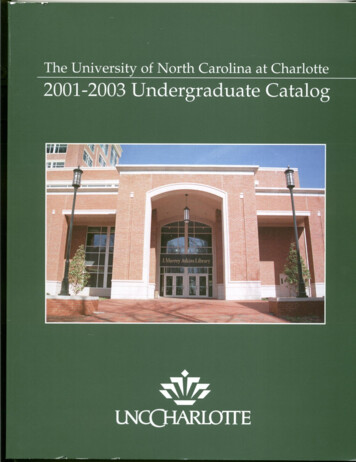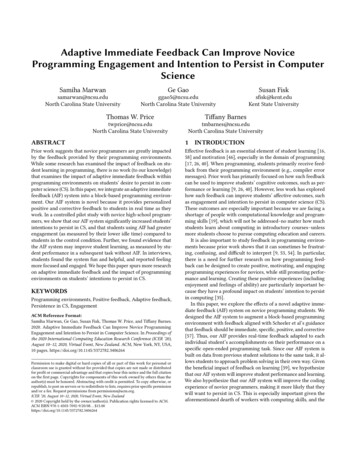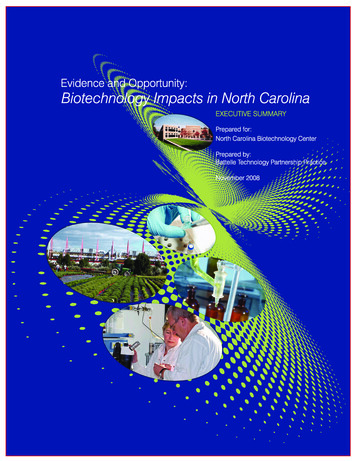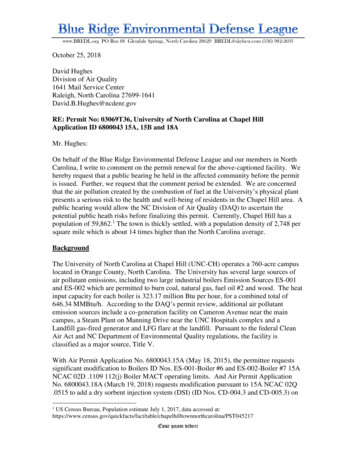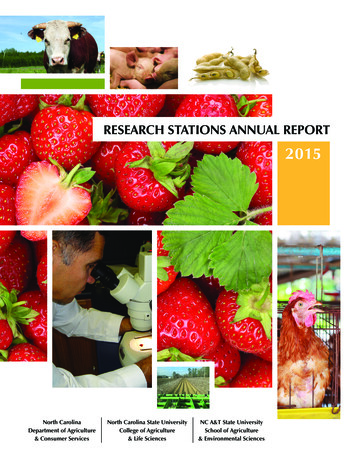
Transcription
RESEARCH STATIONS ANNUAL REPORT2015North CarolinaDepartment of Agriculture& Consumer ServicesNorth Carolina State UniversityCollege of Agriculture& Life SciencesNC A&T State UniversitySchool of Agriculture& Environmental Sciences
OUR MISSIONThe mission of the ResearchStations Division in North Carolinais “to manage crop and livestockfacilities at research stations tosupport agricultural research,extension and teaching programsconducted by universityfaculty across the state.”To that end, the research stationsprovide the testing ground forinnovation and discovery thatundergirds the 76 billion industrythat is North Carolina agriculture.Moreover, this innovation anddiscovery makes national andinternational contributions to foodproduction and food security.AGRICULTURALRESEARCH IS THE KEYThe Research Stations Division is on the front lines of meeting thischallenge. North Carolina is uniquely situated to be at the forefront ofagricultural advances that will feed current and future generations. Alongsimilar latitude, the Research Stations in North Carolina offer a widevariety in soils, climate and cropping systems. Our diversity makes us anextremely attractive place in which to push the bounds of agriculturalproductivity through research. World-class faculty at N.C. State Universityand N.C. A&T State University lead the way, focusing our stations’agricultural research on new technology, improved crop varieties, betterutilization of available resources, and increased production efficiency.NORTH CAROLINA IS INVESTEDIN AGRICULTURAL RESEARCHWith its 18 research stations and incredibly diverse soils and climate, itsworld-class research faculty at N.C. State and N.C. A&T, and its proximityto Research Triangle Park, North Carolina is situated as a hotbed forresearch in agriculture. North Carolina is a top-10 agricultural state interms of cash receipts from farming. North Carolina is unique in thatits research stations are a partnership of both the N.C. Department ofAgriculture and Consumer Services and N.C. State University, Collegeof Agriculture and Life Sciences. Of those top-10 states, only Texas hasmore off-campus research stations than North Carolina. And, it is a wiseinvestment. According to a 2011 study published by the University ofCalifornia-Davis, there is a 19.90 return on every 1 of public fundsspent on agricultural research in North Carolina over the life of thetechnology created.IMPACT SNAPSHOT OF RESEARCH STATIONSWith its critical mass of faculty and research stations, new information and technology to benefit North Carolina farmersis generated daily. It is impossible to list all new and exciting things that come from agricultural research efforts in NorthCarolina. To provide a glimpse, here are four examples of exciting research outcomes: NC leads the nation in sweet potato production and 93 percent of North Carolina’s sweet potato acreage isplanted with the Covington variety, which was developed on state research stations. Moreover, the sweet potatobreeding program at NCSU is the world’s leader and recent recipient of a Bill and Melinda Gates Foundation grantto develop sweet potatoes to alleviate world hunger and food shortages. NCSU researchers in the College of Agriculture and Life Sciences released 18 plant varieties in 2015; most of thesereleases involved work at multiple research stations. In 2015, NC State’s College of Agriculture and Life Sciences researchers published 936 peer-reviewed journalarticles; a significant number of these articles contained data derived from research conducted on researchstations.In 2009, the Research Stations initiated a strategic planning process in which four main goals were identified as critical tomeeting the mission. The progress in 2015 for each goal is summarized, with some key highlights in this report.2 R E S E A R C H S TAT I O N S 2 0 1 4 A N N UA L R E P O R TEXECUTIVE SUMMARYIn 2009, the Research Stations initiated a strategic planning processin which four main goals were identified as mission critical. Progressfor each goal in 2015 is summarized in this report.FEEDING THEWORLD BY 2050Key highlights include:World population isprojected to reach 9 billionby the year 2050. In orderto meet the demand ofthe world’s burgeoningpopulation, food productionwill have to at least doubleover the next 35 croppingseasons. Food security quicklybecomes a national securityissue when scarcity occurs.So, the challenge of feedingthe world’s growing populationis critical to a healthy,prosperous and stable state,country and world.Over FY 13-14 and FY 14-15, 5 million was appropriated forresearch stations to upgrade equipment. Over the two-yearappropriation, the Research Stations acquired 7.79M of newequipment. This was done by leveraging the trade-in value ofoutdated equipment as well as some self-generated receipts. Intotal, 165 pieces of modern agricultural equipment were acquiredfor supporting agricultural research across North Carolina. Theseincluded tractors, planters, irrigation equipment, harvesters, utilityvehicles, and more which greatly enhances the capacity, precision,and relevance of agricultural research on the Stations.Building on previous years’ efforts to improve the beef cattleresearch platform in North Carolina, embryo transfer (ET) from thesuperior cattle at Upper Piedmont Research Station near Reidsvillecontinues to be the primary method of establishing uniformgenetics among all of the resident herds. The goal continues to begenetic improvement and consistency, allowing for research thatis not limited by cow numbers at any one station. Several researchprojects focused on fescue toxicosis have been initiated as a resultof the increased capacity across all of the stations dealing with beefcattle.In 2015, the Bioenergy Research Initiative (BRI) initiated its thirdgrant cycle by awarding 1 million to 12 separate projects. Nineprojects are with NCSU, two with Carolina Land & Lakes RC&DCouncil and one is with Appalachian State University. The portfolioof projects expanded beyond production of trees and perennialgrasses to include using wood pellets for heat and developing abiomass/bioenergy roadmap.The Research Stations continued to utilize a regional managementapproach that takes advantage of the diversity and “connectedness”of the system. The sharing of both labor and equipment resourcesis becoming the norm and a standard way of doing business.Efficiencies are gained and capability at individual stations isenhanced by pooling resources to accomplish the research mission.During 2015, Research Stations hosted 474 agricultural researchprojects with 117 faculty at NC State, NC A&T, and USDA-ARS,utilizing 1,233 acres in small plots (not including land for pasturesand forages). The Stations hosted over 15,000 registered visitors at398 separate events such as field days, seminars, workshops, andother training events.R E S E A R C H S TAT I O N S 2 0 1 4 A N N UA L R E P O R T 3
Our GoalsGoal 1: Enhance Infrastructure for High-Quality Applied Agricultural ResearchGoal 2: Ensure Efficient Research Station and Farm ManagementGoal 3: Enhance Working Relationships and CommunicationGoal 4: Strengthen Outreach, Extension and EducationGOAL 1: ENHANCE INFRASTRUCTURE FOR HIGH-QUALITYAPPLIED AGRICULTURAL RESEARCHNew Equipment for Research Stations: The 2013General Assembly invested in agricultural researchin North Carolina to replace and upgrade an agingfleet of equipment and outfit stations with the mostmodern equipment possible for high quality, preciseand relevant research. An appropriation of 5 millionwas made for the research stations to upgradeequipment over two fiscal years.During the two-year implementation, the ResearchStations Division acquired 7.79M of new equipment.This was done by leveraging the trade-in value ofoutdated equipment as well as some self-generatedreceipts. In total, 165 pieces of modern agriculturalequipment were acquired for supporting agriculturalresearch across North Carolina. These includedtractors, planters, irrigation equipment, harvesters,utility vehicles, and other equipment.A summary of the equipment upgrade over two fiscalyears follows:4Total Legislative appropriation 5 millionLeveraged value of trade-in equipment 1.98 millionAdditional self-generated receipts 910,000Total value of new equipment acquired 7.79 millionNumber of new equipment pieces acquired165Precision Ag Investment: Building on investmentsfrom previous years, more technology has beendeployed on the stations resulting in greater precision,more efficiency and more relevant research tosupport the high-tech agricultural industry. TheResearch Stations Division continue to advance in thedeployment of GPS-related technology and wirelessconnectivity. The advantages are many, but includegreater precision in implementing research, increasedefficiency for operations, and replicating productionpractices more similar to current agricultural practicesin North Carolina. Research Station superintendents arefinding creative ways to implement technology in allfacets of the research program.Enhancement of the Beef Cattle Research Resourcesin North Carolina: The system continues to developa uniform herd of cattle to better support researchprograms in the animal and forage area by coordinatinghusbandry activities between all of the stations asprescribed in the 2013 plan. We are seeking to increasethe capacity for researchers to compete nationallyand have initiated several projects related to fescuetoxicosis.Embryo Transfer from the superior cattle at UpperPiedmont Research Station near Reidsville continuesto be the primary method of establishing uniformgenetics among all of the resident herds. Heifers R E S E A R C H S TAT I O N S 2 0 1 4 A N N UA L R E P O R Tborn at MountainResearch Stationnear Waynesville andButner Beef CattleField Laboratory,which were ET calvesthemselves, are beingbred to become futurereplacements for thecurrent cross bred cowherd. The productionof these females will accelerate the establishment of auniform set of cows.Bovine genetic progress is slow; as the generationalinterval of cattle is more than four years. During thisphase, the infrastructure within the system is beingupgraded. Examples of improvements include fixedknot fencing at multiple research stations, improvedsurface-water management, working facilities andenhanced utilization of forage resources acrossmultiple stations. All locations are active participantsin the CattleMax system that coordinates the trackingof cattle resources within the system.While concrete progress toward the 2013 plan can bemeasured in both cattle genetics and infrastructure,the most notable changes can be observed in theinteraction between the staff at these locations. Thecurrent system allows for the optimization of resourcesby allowing the staffs to work together for thecommon good of all locations. The team has foundinnovative ways of capturing the opportunities thatexist because of the different environmentswithin the system.Training programs: While investing in equipmentis important, our people are our greatest resources.Staff from all 18 research stations have taken partin professional development opportunities and willcontinue to do so. In 2015, four research stationsuperintendents were invited to give presentationsat national meetings to their peers from researchstation systems around the country. Numerousresearch technicians and specialists attendedtrainings, seminars and conferences related to theirwork area, such as the Southeast Vegetable GrowersConference, Tobacco Workers Conference and theBeltwide Cotton Conference. Many serve on local andstatewide boards. The Research Stations Division willcontinue to invest in its people so that we not onlykeep current, but are leaders in the development anduse of newer and greater technology.Forestry Program: The forest management programhas installed three new forest research projectsand continues to host seven existing projects. Therelationship with NCSU’s College of Natural Resourcescontinues to grow and we are optimistic that wewill continue to increase forest research on divisionlands. Educational use of the Research Stations’forestland has increased and so far this year hasincluded four faculty field tours, four class tours, theuse of the Umstead Research Station by the seniorcapstone course in forest management at NCSU,and two undergraduate student research and workprojects. Forest harvests have been within the plannedallowable acreage limits to ensure sustainability.Harvested areas have been reforested to ensurecontinued stand improvement and the potential forfuture management. The Forest Management Programof the NCDA&CS Research Stations Division continuesto accomplish its assigned objectives.North Carolina Bioenergy Research Initiative:In 2015, the Bioenergy Research Initiative (BRI)initiated its third grant cycle by awarding 1 M to 12separate projects. Nine projects are with NCSU, twowith Carolina Land & Lakes RC&D Council and oneis with Appalachian State University. The portfolio ofprojects expanded beyond production of trees andperennial grasses to using wood pellets for heat anddeveloping a biomass/bioenergy roadmap.BRI hosted a field day at the Mountain HorticulturalCrops Research Station in Henderson County withover 130 attendees representing land owners,academia from high school to researchers, andindustry leaders. BRI conducted its first Research/Industry Update meeting with 85 attendees.BRI hosted Leadership Granville, offered supportto start-up companies, and participated in severalhigh school career days. One high school studentvolunteered weekly for on-the-job-training and extracurricular experiences.R E S E A R C H S TAT I O N S 2 0 1 4 A N N UA L R E P O R T 5
implementation of modern technology to researchproject and farm management will continue in 2016.GOAL 2: ENSURE EFFICIENT RESEARCHSTATION AND FARM MANAGEMENTAn internal review of all research stations and fieldlaboratories was started in 2015, with superintendentsconducting a peer-review process, and a system-wideanalysis of labor utilization. Additionally, campusfaculty listening sessions were conducted to gainfeedback from researchers about research stationsefforts.Research is conducted on over 80 commodities produced in NorthCarolina. We have one of the most diverse agricultural states in thenation, which is supported by research on our 18 research stations.By the Numbers:Research faculty at NC State, NC A&T, and USDA working on NC Research StationsResearch projects conducted across the systemGraduate students working on and receiving training on the research stationsAcres devoted to small-plot research (not including land for forages)Field days, seminars, and other training and educational eventsNumber of attendees at field days, seminars, and other training and educational eventsRegional Management: In 2015, the ResearchStations continued to utilize a regional managementapproach that takes advantage of the diversity andconnectedness of the system. The sharing of bothlabor and equipment resources is becoming the normand a standard way of doing business. Efficienciesare gained, and capability at individual stations isenhanced, by pooling resources to accomplish theresearch mission.Just as important, the regional approach has allowedsome staff to specialize in certain areas and becomea resource upon which multiple stations can call.An example is the precision ag technology wheresome research technicians and specialists have beenable to quickly learn and train other stations in itsuse. Another example in cattle management is thespecialization some staff have acquired in techniquessuch as embryo transfer which can be utilized onmultiple stations in the beef program. Several stationsno longer have office support, but rather shareoffice support with other stations. Management hasencouraged this form of professional developmentand sharing of talent.Safety: The safety and welfare of our employeesis a paramount concern. Moreover, agriculture isan occupation with numerous, inherent hazards.Recognizing these realities, as well as the high cost ofworker’s compensation claims, the Research Stationsre-allocated two vacant positions into safety officerpositions in December of 2013. The safety officerswork as a team, with one covering Eastern North61174741531,23339815,064Carolina and the other focused on the Western partof the state. The goal is for Research Stations’ safetyprogram to be proactive in hazard recognition andavoidance, training, and responsiveness to safetyrelated issues rather than just being a “check the box”program.The emphasis on safety has made our workingenvironment one that is better for employees, andresults in less lost time and worker’s comp expenses.In 2015, the worker’s comp cost from the ResearchStations Division was reduced for the second year ina row. We continue to emphasize all aspects of safety,especially hazard avoidance. Each time an incident(injury or near-miss) occurs, a simple electronic noticeis sent to all units within 24 hours. The sharing ofinformation concerning hazards is critical to hazardrecognition and avoidance.Efficiency through technology: To a great extent, thesuccess of research relies on good communicationand accurate record-keeping. Research Station staffstrive to have the best communication possible,with research project staff and maintain a myriadof records related to the projects, as well as routinesafety inspections, inventories, and production recordsfor each farm. Several pilot projects were initiatedin 2015 to utilize wireless technology, cloud storage,tablets, and cell phones to streamline communicationand record-keeping. These have proven to bebeneficial, providing more readily accessible andefficient forms for implementing research projectsand maintaining records and inventories. Further R E S E A R C H S TAT I O N S 2 0 1 4 A N N UA L R E P O R TA large data project was sponsored by the Associationof Public and Land-Grant Universities (APLU) andwas entitled “A National Study of Capital & DeferredMaintenance at Schools of Agriculture”. The DeferredMaintenance study required each off-campus locationto identify buildings, type of structure, age of structureand any renovations. In total, 1,039 buildings / orstructures on the off-campus locations were enteredinto the APLU data base.GOAL 3: ENHANCE WORKING RELATIONSHIPSAND COMMUNICATIONRelationship with NC StateAdministrationAdministration at NCDA&CS and NCSU meet at least monthly to facilitateeffective management and strategic decision-making.Advisory GroupsFaculty Advisory Committees were formed for each research station in 2013,and continued to function in 2015. The role of the advisory committees is tofurther enhance communication between research faculty and stations as itrelates to strategic planning and utilization of resources and facilities to ensurethe research needs of faculty are being met.PartnershipsStrategic partnerships between NCDA&CS, NCSU, USDA-ARS, andcommodity groups resulted in station upgrades, improvements and overallresearch capability.Center for EnvironmentalFarming Systems (CEFS)The Cherry Research Farm continues to anchor research and field activities fororganic farm practices. CEFS is also a springboard for statewide initiatives suchas the “10% Campaign” aimed at increasing consumption of North Carolinaproducts.Research stations host a number of multi-state projects such as the SUNGrainsbreeding initiative for wheat, oats and barley, as well as integrated pestmanagement programs.Multi-State ProjectsIn 2015, the Research Stations Division hosted the Research CentersAdministrators Society annual summer meeting. RCAS is the nationalorganization for research farm managers. During the four-day meeting, around100 colleagues from across the country were introduced to our researchstations and agriculture in North Carolina, prompting a healthy exchange ofinformation.R E S E A R C H S TAT I O N S 2 0 1 4 A N N UA L R E P O R T 7
SNAPSHOTS OF AGRICULTURAL RESEARCH IMPACTSThe following are quotes from NC State Research Faculty that illustrate the importance of theResearch Stations to agriculture research and moving agriculture forward in North Carolina:“Although we utilize 15 to 20 acres of field space at several research stations annually, two of themost important sets of data we collect each year come from ‘out of the way’ tests of approximately1.5 acres each at the Cunningham Research Station at Kinston.GOAL 4: STRENGTHEN OUTREACH,EXTENSION AND EDUCATIONOne of the best ways to breed wheat is to learn how to grow the crop properly, and then doeverything slightly wrong. The second important test is a headache for station management becausewe ask them to disk up a corner of a no-tilled soybean field before it can be harvested. Then weplant wheat a month early in September!! In this test, we evaluate wheat varieties and breedinglines for resistance to Hessian fly, another major pest of N.C. wheat. The worst management practiceone can follow, if you have a Hessian fly issue, is early planted wheat into a no-tilled soybean crop.We always get great data!” — Dr. Paul Murphy, Professor & Small Grain Breeder, NCSUField Days Research Stations hosted 398 field days, seminarsand trainings focused on beef, soybeans, smallgrains, peanuts, tobacco, blueberries, turfgrass,vegetables, tree fruits, and other commodities. In 2015, stations participated heavily in a newpollinator habitat area pilot project with privatesupport. Recognizing the value of pollinators acrossthe landscape, all 18 stations established pollinatorhabitat plots to provide host plants for the myriadof pollinators present in North Carolina. Each wasappropriately signed and served a dual function ofincreasing pollinator habitat and increasing publicawareness. In 2016, plans are to expand andmonitor these plots with NC State faculty to assessthe status of pollinators on our research stations andthe impact of increased habitat area. Partnerships with Cooperative Extension andResearch Stations continued to strengthen in 2015.Multiple training events were held for extensionat research stations. A concerted effort was madeto more closely involve Cooperative Extension infield days, while providing a training opportunityfor research station and extension staff. Researchersand specialists were engaged in the planning processfor field days to provide training for extensionagents and research station staff, with the goal ofboth being able to provide more of the content forresearch station attendees. Notable successes werethe number of Extension Agents and Research Staffmaking presentations at the Small Grains and Beeffield days. Visitors to the Research Stations in 2015 were ableto ride in trams, or people movers, purchased in2013 and 2014, as they learned about agriculturalresearch ongoing at the stations. The trams conformto all safety standards and ensure a comfortable,8The first is a specially irrigated and inoculated test of Fusarium Head Blight (Scab) resistance inwheat breeding lines and varieties in the N.C. Official Variety Test. Scab is the single biggest threat tothe state’s wheat crop, so it is vital we collect data annually on the resistance levels of the varietiesbeing grown here.safe experience for visitors to our research stationswhile reducing the state’s liability. Moreover, theyare able to be easily towed between stations foruse where needed and when needed for visitors toenjoy events on the Research Stations. The tramsare in high demand and are frequently movedaround the state for our events.Ag and Science Teachers Central Crops Research Station is working with ateacher and student from Clayton High School tocollect 14 soil monoliths, which will be preservedand utilized for future soils classes. The Northeast Region Biotechnology/AgriscienceHigh School completed its third year. After beingtemporarily located in the Vernon James Centerlocated at the Tidewater Research Station, theschool relocated to nearby Jamesville. Studentscontinued to be frequent visitors to the TidewaterResearch Station and worked on numerous projectsat that site with Research Station staff and facultyfrom NCSU. The Mountain Research Station in Waynesvilleworked with Haywood County schools andCooperative Extension’s 4-H program to host youthshooting sports workshops and activities. R E S E A R C H S TAT I O N S 2 0 1 4 A N N UA L R E P O R T“Research stations have been invaluable in my work on weed management. In recent years, muchof my work has been with transgenic crops under USDA-regulated status. The security offered onstations and the assurance that the crop will not be accidentally harvested and enter commercialchannels has been essential for the work. Also, weed managementresearch is dependent upon uniform and heavy weed infestations.Many of the stations maintain fields dedicated to weed research.There will be non-treated checks and plots with less-than-adequatecontrol. This makes on-farm research difficult as most growersunderstandably do not want weeds in their fields. Station managersunderstand our needs and “tolerate” our weeds.” — Dr. Alan York,William Neal Reynolds Professor, Crop Science, NCSU“In terms of economic importance, the pig industry is the secondlargest agricultural commodity in North Carolina. Hence technologydevelopment is needed to sustain North Carolina pig farmers anduplift our rural communities. The partnership between NCDA research stations and NC Statescientists provides a competitive advantage for North Carolina pig farmers. Research projectsconducted through this collaborative effort develop near- and long-term solutions that enhancefarmer profitability. Studies conducted at the NCDA Tidewater Research Station are essential tomy research program. This collaborative effort allows me to address the immediate- and longterm technology needs of North Carolina pig farmers, train future scientists and leverage outsidefunding.” — Dr. Mark Knauer, Assistant Professor & Extension Specialist, Animal Science, NCSUMountain Horticultural Crops Research Station. Photo by Marc Hall.“Research stations have been and continue to be critical to the success of NC State’s agriculturalresearch programs and our decades-long partnership has been extremely productive. Virtually all ofthe new varieties, and the cultural management programs developed for them, have at some pointbeen tested on one or more of NCDA&CS’ research stations prior to on-farm testing. NC’s farmershave benefited greatly from this work, and I think if you asked any farmer in NC about this, theywould certainly agree.” — Dr. Craig Yencho, Professor & Sweet Potato Breeder, NCSUR E S E A R C H S TAT I O N S 2 0 1 4 A N N UA L R E P O R T 9
NORTH CAROLINARESEARCH STATIONSUPPERPIEDMONTRESEARCH STATION(LAUREL SPRINGS)* Items in bold are primary reasearch interestsPIEDMONTTIDEWATERRESEARCH STATION(PLYMOUTH)CUNNINGHAMRESEARCH RALCROPSRESEARCH STATION(MILLS RIVER)CUNNINGHAM/LOWER COASTAL:Tobacco (Flue-cured, Burley, Dark Air-Cured),Horticultural Crops (Brambles, Melons,Watermelons, Sweet Potatoes, Lettuce, Cabbage,Squash, Cucumbers), Corn10RESEARCH STATION(LEWISTON WOODVILLE)RALEIGHASHEVILLECHERRY FARM: Grass-based Dairy, Beef,Antibiotic-free Swine, Corn, Soybeans, Cotton,Specialty Crops, Organic Farming, Goats, WetlandsRestoration, Waste Composting, Riparian BuffersMOUNTAIN HORT: Tomatoes, Ornamentals,Apples, Peaches, Strawberries, Blueberries,Brambles, Peppers, Cucurbits, Soybeans, Corn,Aquaculture, Greenhouse ProductionRESEARCH STATION(ROCKY MOUNT)PEANUT BELTRESEARCH FARM(BUTNER)RESEARCH STATION(WAYNESVILLE)CENTRAL CROPS: Field Crops (Corn, Soybeans,Cotton, Small Grains), Tobacco, Swine, HorticulturalCrops (Melons, Peaches, Apples, Strawberries,Sweet Potatoes, Squash), CanolaMOUNTAIN: Specialty Crops, Christmas Trees,Heirloom Tomatoes, Forages, Beef, Wheat, Corn,Burley Tobacco, Alternative CropsUMSTEADUNIVERSITY FARM(GREENSBORO)UPPERCOASTAL PLAINGREENSBOROMOUNTAINCASWELL FARM: Field Crops (Soybeans, Corn,Wheat), Organic Crops (Soybeans and Cotton),Invasive Weed Ecology, Native GrassesHORTICULTURAL CROPS, CASTLE HAYNE:Blueberries, Strawberries, Grapes, Cucumbers,Watermelon, Woody Ornamentals, Woody FruitSpecies, Sea Oats, Coastal Beach GrassNC A&TRESEARCH STATION(OXFORD)RESEARCH STATION(SALISBURY)BORDER BELT: Field Crops (Tobacco, Soybeans,Corn, Peanuts, Small Grains)HORTICULTURAL CROPS, CLINTON:Horticultural Crops (Cucumbers, Melons,Sweet Potatoes, Peppers, Blueberries, Grapes,Strawberries, Watermelon, Tomatoes), Field Crops(Soybeans, Corn)RESEARCH RCH STATION(KINSTON)SANDHILLSRESEARCH STATION(JACKSON SPRINGS)CHERRYRESEARCH STATION(GOLDSBORO)CENTRALCROPSRESEARCH STATION(CLAYTON)OXFORD TOBACCO: Tobacco, Tobacco Diseases,Tobacco Germplasm, Cucumbers, Melons,Paulownia Trees, Biofuel FeedstocksBORDERBELT TOBACCORESEARCH CROPSRESEARCH STATION(CASTLE HAYNE)RESEARCH STATION(CLINTON)PEANUT BELT: Peanuts, Corn, Cotton, Wheat,Soybeans, Cucumbers, Melons, Snapbeans,Sorghum, Sage, FescuePIEDMONT: Poultry, Dairy, Corn, Soybeans, Hay,Small Grains, Wheat, Tomatoes, Strawberries,Caneberries, Blueberries, High Tunnel ProductionSANDHILLS: Peaches, Blueberries, Turfgrass, Corn,Soybeans, Caneberries, Peppers, Strawberries,Ornamentals, Peanuts, Sweet Potatos, Cotton, RyeTIDEWATER: Soybeans, Corn, Cotton,Aquaculture, Swine, Beef, Irish Potatoes, Rice,Canola, Sweet Sorghrum, Small Grains R E S E A R C H S TAT I O N S 2 0 1 4 A N N UA L R E P O R TUMSTEAD: Forestry, Water Quality, BiofuelFeedstocks, Weed Management, Forage ProductionUPPER COASTAL PLAIN: Peanuts, Cotton,Soybeans, Corn, Tobacco, Cucurbits, Small Grains,Switchgrass, Trees, Weed ManagementUPPER MOUNTAIN: Beef, Goats, Christmas Trees,Strawberries, Brambles (Raspberri
NORTH CAROLINA IS INVESTED IN AGRICULTURAL RESEARCH With its 18 research stations and incredibly diverse soils and climate, its world-class research faculty at N.C. State and N.C. A&T, and its proximity to Research Triangle Park, North Carolina is situated as a hotbed for research in agriculture. North Carolina is a top-10 agricultural state in

